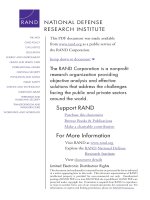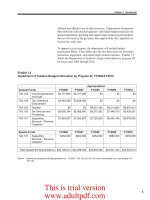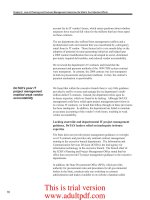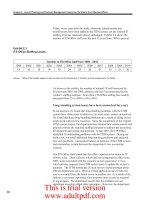Lecture Principle of inventory and material management - Lecture 14
Bạn đang xem bản rút gọn của tài liệu. Xem và tải ngay bản đầy đủ của tài liệu tại đây (411.81 KB, 38 trang )
Lecture 14
Production Activity Control (Continued)
Books
•
Introduction to Materials Management, Sixth Edition, J. R. Tony Arnold, P.E., CFPIM, CIRM, Fleming
College, Emeritus, Stephen N. Chapman, Ph.D., CFPIM, North Carolina State University, Lloyd M.
Clive, P.E., CFPIM, Fleming College
•
Operations Management for Competitive Advantage, 11th Edition, by Chase, Jacobs, and Aquilano, 2005,
N.Y.: McGrawHill/Irwin.
•
Operations Management, 11/E, Jay Heizer, Texas Lutheran University, Barry Render, Graduate School of
Business, Rollins College, Prentice Hall
Objectives
•
•
•
•
•
•
•
•
Sequencing
Slack
Johnson's Rule
Monitoring
Advance planning and scheduling
TOC
Scheduling procedure
Employee Scheduling
Sequencing
•
•
•
Prioritize jobs assigned to a resource
If no order specified use firstcome firstserved (FCFS)
Other Sequencing Rules
–
–
–
–
–
–
–
–
–
FCFS firstcome, firstserved
LCFS last come, first served
DDATE earliest due date
CUSTPR highest customer priority
SETUP similar required setups
SLACK smallest slack
CR smallest critical ratio
SPT shortest processing time
LPT longest processing time
Minimum Slack & Smallest Critical Ratio
•
SLACK considers both work and time remaining
SLACK = (due date – today’s date) – (processing time)
•
CR recalculates sequence as processing continues and
arranges information in ratio form
time remaining
CR = =
work remaining
due date today’s date
remaining processing time
If CR > 1, job ahead of schedule
If CR < 1, job behind schedule
If CR = 1, job on schedule
Sequencing Jobs Through One Process
•
•
•
Flow time (completion time)
– Time for a job to flow through system
Makespan
– Time for a group of jobs to be completed
Tardiness
– Difference between a late job’s due date and its
completion time
Simple Sequencing Rules
JOB
PROCESSING
TIME
DUE
DATE
A
B
C
D
E
5
10
2
8
6
10
15
5
12
8
Simple Sequencing Rules: FCFS
FCFS
SEQUENCE
START
TIME
A
B
C
D
E
0
5
15
17
25
PROCESSING COMPLETION DUE
TIME
TIME
DATE
5
10
2
8
6
Total
Average
5
15
17
25
31
93
93/5 = 18.60
10
15
5
12
8
TARDINESS
0
0
12
13
23
48
48/5 = 9.6
Simple Sequencing Rules: DDATE
DDATE
SEQUENCE
START
TIME
C
E
A
D
B
0
2
8
13
21
PROCESSING COMPLETION DUE
TIME
TIME
DATE
2
6
5
8
10
Total
Average
2
8
13
21
31
75
75/5 = 15.00
5
8
10
12
15
TARDINESS
0
0
3
9
16
28
28/5 = 5.6
Simple Sequencing
Rules: SLACK
SLACK
SEQUENCE
START
TIME
E
C
D
A
B
0
6
8
16
21
A(100) – 5 = 5
B(150) – 10 = 5
C(50) – 2 = 3
D(120) – 8 = 4
E(80) – 6 = 2
PROCESSING
TIME
COMPLETION DUE
TIME
DATE
6
2
8
5
10
Total
Average
6
8
0
8
5
3
16
12
4
21
10
11
31
15
16
82
34
82/5 = 16.40 34/5 = 6.8
TARDINESS
Simple Sequencing Rules: SPT
SPT
SEQUENCE
START
TIME
C
A
E
D
B
0
2
7
13
21
PROCESSING
TIME
2
5
6
8
10
Total
Average
COMPLETION DUE
TIME
DATE
TARDINESS
2
5
0
7
10
0
13
8
5
21
12
9
31
15
16
74
30
74/5 = 14.80 30/5 = 6
Simple Sequencing Rules: Summary
RULE
FCFS
DDATE
SLACK
SPT
AVERAGE
COMPLETION TIME
18.60
15.00
16.40
14.80
Best values
AVERAGE
TARDINESS
9.6
5.6
6.8
6.0
NO. OF
JOBS TARDY
3
3
4
3
MAXIMUM
TARDINESS
23
16
16
16
Sequencing Jobs Through Two
Serial Process
Johnson’s Rule
1.
2.
3.
4.
5.
List time required to process each job at each process. Set up a one
dimensional matrix to represent desired sequence with # of slots
equal to # of jobs.
Select smallest processing time at either process. If that time is on
process 1, put the job as near to beginning of sequence as possible.
If smallest time occurs on process 2, put the job as near to the end
of the sequence as possible.
Remove job from list.
Repeat steps 24 until all slots in matrix are filled and all jobs are
sequenced.
Sequencing
With
Excel
Johnson’s Rule
JOB
PROCESS 1
PROCESS 2
A
B
C
D
E
6
11
7
9
5
8
6
3
7
10
E
A
D
B
C
Johnson’s Rule
E
E
A
5
A
D
D
11
B
C
B
Process 1
(sanding)
C
20
31
38
Idle time
E
5
A
15
D
23
Completion time = 41
Idle time = 5+1+1+3=10
B
30
Process 2
(painting)
C
37
41
Excel for Johnson’s Rule
User inputs processing
times and sequence
Excel calculates
completion times
and makespan
When the set of
jobs is completed
Guidelines for Selecting a Sequencing Rule
•
•
•
•
•
•
SPT most useful when shop is highly congested
Use SLACK for periods of normal activity
Use DDATE when only small tardiness values can be
tolerated
Use LPT if subcontracting is anticipated
Use FCFS when operating at lowcapacity levels
Do not use SPT to sequence jobs that have to be assembled
with other jobs at a later date
Monitoring
•
•
•
Work package
– Shop paperwork that travels with a job
Gantt Chart
– Shows both planned and completed activities against a
time scale
Input/Output Control
– Monitors the input and output from each work center
Gantt Chart
Job 32B
Behind schedule
Facility
3
Job 23C
Ahead of schedule
2
Job 11C
Job 12A
On schedule
1
1
Key:
2
3
4
5
6
8
Today’s Date
9
10
11
12
Planned activity
Completed activity
Days
Input/Output Control
PERIOD
Planned input
Actual input
Deviation
Planned output
Actual output
Deviation
Backlog
30
1
2
3
4
65
65
70
70
75
75
75
75
20
10
5
0
TOTAL
270
0
0
300
0
0
Input/Output Control
PERIOD
Planned input
Actual input
Deviation
Planned output
Actual output
Deviation
Backlog
30
1
2
3
4
65
60
-5
75
75
-0
15
65
60
-5
75
75
-0
0
70
65
-5
75
65
-10
0
70
65
-5
75
65
-10
0
TOTAL
270
250
-20
300
280
-20
Excel for Input/Output Control
User inputs
planned and
actual values
Excel calculates deviations
and backlog
Advanced Planning and Scheduling Systems
•
•
Infinite scheduling assumes infinite capacity
– Loads without regard to capacity
– Then levels the load and sequences jobs
Finite scheduling assumes finite (limited) capacity
– Sequences jobs as part of the loading decision
– Resources are never loaded beyond capacity
Advanced Planning and Scheduling Systems
•
Advanced planning and scheduling (APS)
–
–
–
–
Addins to ERP systems
Constraintbased programming (CBP) identifies a
solution space and evaluates alternatives
Genetic algorithms based on natural selection properties
of genetics
Manufacturing execution system (MES) monitors status,
usage, availability, quality
Advanced Planning and Scheduling









